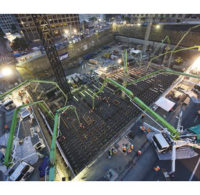Mass placement eliminated construction joints. "It would be nearly impossible to put a construction joint in something with so much reinforcing steel," says Gerard Nieblas, president of local structural engineer Brandow & Johnston Inc.
During the two-week curing period, a temporary chiller feeds water through 100,000 ft of polyethylene tubing that is embedded throughout the mat to keep the concrete below 160°F.
Crews then will assemble a concrete formwork climbing system for the tower's core atop the mat. Core walls will be 4 ft thick at the base; they gradually narrow to 2.5 ft of thickness at the tower's top.
Since the slender core's lateral system is just over 30 ft wide in the transverse building direction, diagonal buckling- restraining brace frames will be added on three levels to "act as a fuse for the lateral system to limit the overturning to the outrigger columns," Nieblas says.
The tower will contain a 900-room hotel; offices for its developer, Korean Air; retail space and five levels of underground parking. When opened in 2017, the tower will have incorporated 150,000 cu yd of concrete, 21,700 tons of structural steel and 18,000 tons of reinforcement steel.






Post a comment to this article
Report Abusive Comment